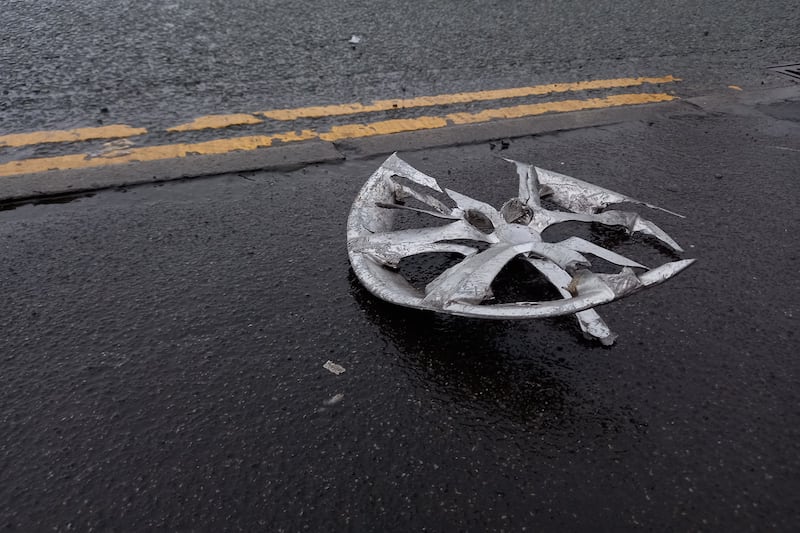Rehearsal studios are a bit like classrooms: even a quick visit will reveal the learning dynamic. Is there a contented hum of collaborative activity from everyone, a passive silence from those waiting to be told what to do, or downright chaos? The first impression of Junk Ensemble's rehearsals for Dusk Ahead is of quiet, insistent productiveness.
A giant sculpture of strings stretching from floor to ceiling dominates one side of the space. Beside it, one of Junk Ensemble's artistic directors and choreographers, Jessica Kennedy, works out the practicalities of a dancer trying to move with a rope tied around her waist. On the other side of the studio, Megan Kennedy is polishing a rhythmic unison sequence with three dancers. It is nit-picky stuff, as they focus on one small jump that isn't perfectly together.
“Do you want to break for lunch now?” Megan Kennedy asks the dancers.
“Let’s try it one more time,” comes the reply.
Eventually, after discussion and dissection, the split-second synchronisation is worked out.
The studio experience isn’t surprising. Since it emerged in 2004, Junk Ensemble has shown a remarkable ability to draw diverse elements into a unified whole, while still remaining focused on the smallest details.
It might have been tempting for the Kennedy twins to create broad brush strokes of choreography when dealing with a mix of professional dancers and children in previous works such as The Falling Song or Bird with Boy, but instead they produced subtle pointillist choreography where every element was integral to the overall concept.
Megan and Jessica Kennedy may be identical twins, but that doesn’t guarantee a harmonious rehearsal studio. “Our early works were duets for ourselves, so it was fine if we were bickering,” says Megan, but as they worked with bigger casts they had to be more professional than familial.
Very individual twins
These are not the kind of twins who complete each other's sentences. "We tend to talk over each other," warns Megan as I set up my voice recorder in front of them.
Sure enough, the interview is a fascinating counterpoint of opinions as one speaks over the other, sometimes agreeing, sometimes contradicting, but always enriching each other’s statements.
Dusk Ahead revisits some of the themes found in earlier work: memories, illusiveness, and a state of in-betweenness.
“We’re really focusing on the idea that dusk is the hour between dog and wolf, between domestic and wild, and between hope and fear,” says Jessica. Encroaching darkness also raises issues around blindness and invisibility, and at different times the dancers move wearing blindfolds.
“And they really are blindfolded,” says Megan. Rather than use transparent cloth, they wanted the dancers to be genuinely uncertain in their movements.
“They genuinely don’t know what is ahead, and that uncertainty is beautiful to look at,” says Jessica. “And it’s amazing; even the smallest movement feels bigger than it looks when you’re wearing a blindfold.”
Although content to let multiple meanings emerge in their choreography, they did have a problem with using a black blindfold. “It’s seems so archetypal and sinister, but we tried grey and white, but returned to black,” says Jessica.
Research in Newcastle
Moving blindfolded on a set-strewn stage might seem hazardous, but the choreographers are not asking the dancers to do anything that they wouldn't do themselves. The pair spent two weeks researching Dusk Ahead in Dance City in Newcastle upon Tyne, where they tried out ideas blindfolded, as well as facilitating workshops with visually impaired groups.
Time was also spent gathering a broad range of influences: Juan Carlos Fresnadillo's film Intacto, with its extraordinary sequence of blindfolded runners in a forest; photography books; and the writings of Oliver Sacks and José Saragamo.
This research – and watching blind runners at the Paralympics – led them to consider the issue of co-dependency and how dancers move when physically tethered to one other. It also inspired a short dance film called Blind Runner, one of 12 commissioned by Dance Ireland as part of its 21st anniversary celebrations.
This tethering finds resonance in designer Sabine Dargent’s sculptural set, which is dominated by groups of parallel wires dissecting the stage at different angles, and even the strings on Zoe Reardon’s cello and the ukuleles played by the dancers. Probably the most important element will be Sarah Jane Shiel’s lighting design, which mirrors the crepuscular light of dusk.
Harnessing these creative inputs into a coherent whole was a challenge.
“Rather than have a collection of ideas we wanted to combine everything into one arc,” says Jessica. “We edited the material as if it was a film.”
“We are always aware of the audience, not in what they will think about the choreography, but in how they experience it,” says Megan.
This is easier in site-specific works than in the traditional theatre setting, where the audience is at a remove from the action.
"In Bird with Boy [which was performed in the dank basement of Kilmainham Gaol], the audience was being led around different spaces, so we could control what they saw," says Megan. Instead, Dusk Ahead relies on traditional stagecraft to impart its non-narrative themes.
Junk Ensemble’s creations have always been engaging, even if they revel in the illusive. “It’s a metaphoric state that we love to portray,” says Jessica.
Dusk Ahead runs October 1 to 6 as part of the Dublin Theatre Festival. Blind Runner is avilable online at danceireland.ie


















